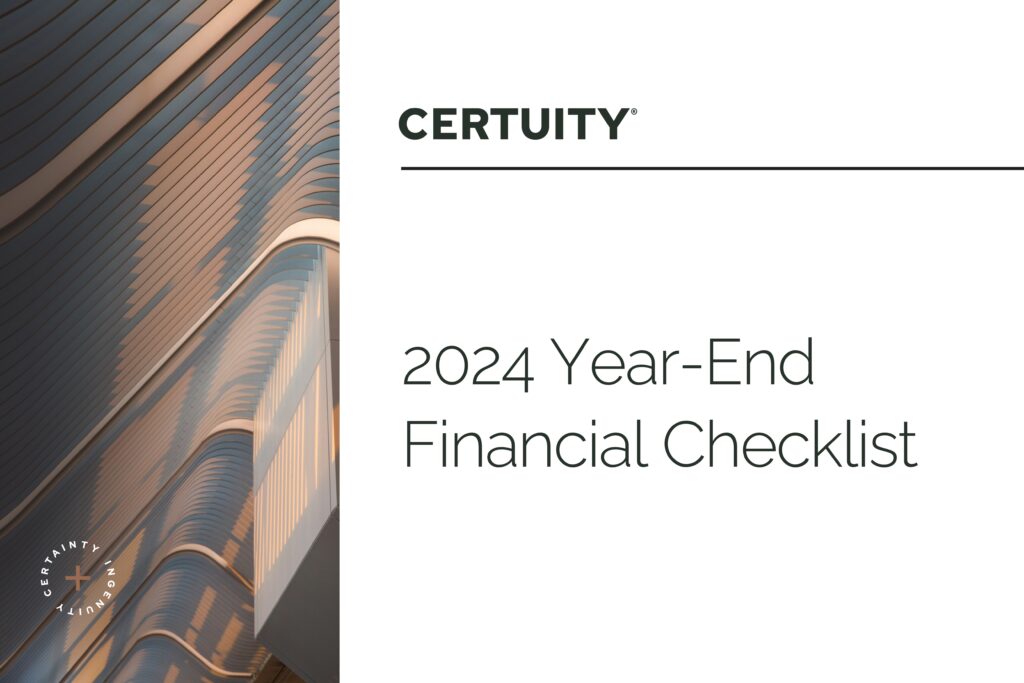
With the end of the year fast approaching, now is the time to connect with your financial advisor to get your financial house in order.
There is much to consider, from tax-loss harvesting, to charitable gifting strategies, to retirement account distributions. The following checklist is an excellent tool to review with your advisor to ensure you end 2024 on a high note and begin 2025 on the right foot.
Looking for a financial advisor? Contact Certuity to be paired with a trusted fiduciary who can walk you through this checklist.
1. Income & Investments
Defer or reduce income
- Income: Defer your year-end bonus, the sale of capital gain property and receipt of distributions to delay income to the following year.
- Deductions: Take your deductions (pay your 2024 Q4 state income tax payment, medical expenses, deductible interest and alimony payments before January 1, 2025).
- W-2 withholding: Increase your W-2 federal income withholding amount in preparation for a significant tax bill or to avoid the under-withholding tax penalty.
- Alternative Minimum Tax: If you are subject to the Alternative Minimum Tax (AMT), or if you are close to being in the AMT, be sure to speak with your CPA or other tax advisor before implementing these strategies.
Offset capital gains
- Tax-loss harvesting: Harvest your losses by selling taxable investments, keeping in mind short-term losses are most effective at offsetting capital gains. Note: Wait at least 31 days before buying back a holding sold for a loss to avoid the IRS wash-sale rule.
- Mutual funds: Evaluate if you should delay purchasing mutual fund shares until after January 1, 2025 to avoid capital gains taxes on brand new investments.
2. Retirement Planning
- IRA: Maximize your IRA contributions. For 2024, the maximum IRA contribution is $7,000, or $8,000 if you’re 50 and above.
- 401(k): Maximize your 401(k) contributions. For 2024, the maximum 401(k) contribution is $23,000, or $30,500 if you’re 50 and above.
- Direct rollover distribution: Avoid mandatory tax withholding by making a direct rollover distribution to an eligible retirement plan, including an IRA.
- Employer stock: Explore taking employer stock under favorable tax rules.
- Social Security: Determine the best time to begin taking Social Security benefits, which you can apply for between ages 62 – 70.
- Required Minimum Distribution: If you’re age 73 and above, take your Required Minimum Distribution (RMD).
3. Gifting Strategies
Gift to loved ones
- Gift Tax: Gift up to $18,000 per individual annually in federal tax-free gifts. If you’re a married couple, you can give up to $36,000 per individual annually.
- Bequest: Make a will or trust bequest so that the estate can take both income and estate tax deductions.
Gift to those in need
- Cash: Give an outright charitable gift of cash for an immediate income tax deduction.
- Stock: Contribute to charities using appreciated stock in place of cash to reduce capital gains in your portfolio while generating an income tax deduction.
- Qualified Charitable Distribution: If you are over 70½, you can donate up to $105,000 from your IRA directly to a charity and avoid paying income taxes on the distribution.
- Donor Advised Fund: Set up a Donor Advised Fund for an immediate income tax deduction and provide immediate and future donor gifting to charity over time.
- Private Foundation: Set up a Private Foundation for an immediate income tax deduction and provide complete control over current and future charitable giving.
4. Account Reviews
- Health Savings Account: Review your Health Savings Account (HSA) contributions. For 2024, the maximum HSA contribution, inclusive of amounts contributed by your employer, is $4,150 for individuals and $8,300 for families, plus an additional $1,000 if you’re 55 and above.
- Flexible Spending Account: Confirm you’ve spent the entire balance in your Flexible Spending Account (FSA) for the year as any money not used may be lost. Consider stocking up on qualified expenses, from over-the-counter medications to contact lenses, to use up leftover funds.
- 529 Plan: Revisit contribution amounts to your 529 Plan school savings accounts. Note: Contribution limits vary by state.
- Medicare Part D: Review your Medicare Part D plan and make any changes during open enrollment, which begins in October.
5. Review 2024 & Plan for 2025
- Financial plan: Review the past year and plan for next year with your advisor to ensure you have clarity in your current situation and direction for tomorrow. Update them on major life events from the past year and share any that are on the horizon (e.g employment, marriage, divorce, children, retirement). Review your spending and share any significant upcoming expenses to make updates to your budget and financial goals (e.g. real estate, college tuition, wedding).
- Investment roadmap: Revisit your account preferences, risk tolerance and investment objectives and ensure they’re all up to date.
- Year-end projection: Send capital gains and investment income information to your accountant for an accurate year-end projection.
- Beneficiaries: Review your beneficiary designations and update them as necessary.
This article is intended for informational purposes only and should not be taken as a recommendation to invest in any asset class or foreign securities market. All investments involve risk including the loss of capital. Certuity is not a tax advisor. All decisions regarding the tax implications of your investments should be made in consultation with your independent tax advisor.